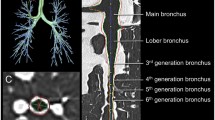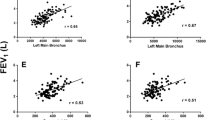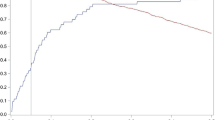Abstract
Tracheal diameter (TD) was measured from standard posterior-anterior (PA) roentgenograms and evaluated as a predictor of pulmonary function. A population of 222 non-smokers with normal chest roentgenograms was analyzed. A subset of the population with the trachea indented two or more mm by the aorta (on PA film), as well as males and females, were analyzed separately. In males without aortic indentation of the trachea, tracheal diameter alone accounted for 28% of the variation in peak expiratory flow rate (PEFR). Age and height accounted for an additional 19% of the variation. Tracheal diameter was second to age as a predictor for forced expiratory volume in one second (FEV1) and forced vital capacity (FVC), accounting for an additional 10% of the variation in each. However, tracheal diameter did not explain significant variability in the female group. This study supports an upper airway effect on flow at large lung volumes. It also demonstrates that a tracheal diameter, measured from a PA chest film, is a useful predictor of pulmonary function that can be easily applied in population surveys.
Similar content being viewed by others
References
Cherniack RM, Raber MB (1972) Normal standards for ventilatory function using an automated wedge spirometer. Am Rev Respir Dis 106:38–46
Dawson SV, Elliott EA (1977) Wave-speed limitation on expiratory flow: a unifying concept. J Appl Physiol 43:498–515
Dolyniuk MY, Fahey PJ, Love L (1982) Tracheal size determines maximal expiratory flow (abstr). Am Rev Respir Dis 125:239
England SJ, Bartlett D, Daubenspeck JA (1982) Influence of human vocal cord movements on airflow and resistance during eupnea. J Appl Physiol 52:773–779
Gardner RM, Hankinson JL, West BJ (1971) Testing spirometer — ATS standards. ATS News 3 (No. 3):24
Green M, Mead J, Turner JM (1974) Variability of maximum expiratory flow volume curves. J Appl Physiol 37:67–74
Gupta CK, Mathur N (1982) Statistical models relating peak expiratory flow rates to age, height and weight in men and women. J Epidemiol Commun Health 36:64–67
Higgins MW, Keller JB (1973) Seven measures of ventilatory lung function. Am Rev Respir Dis 108:258–272
Jesseph JE, Merendino KA (1957) The dimensional interrelationships of the major components of the human tracheo-bronchial tree. Surg Gynecol Obstet 105:210–214
Knudson RJ, Mead J, Knudson DE (1974) Contribution of airway collapse to supramaximal expiratory flows. J Appl Physiol 36:653–667
Knudson RJ, Schroter RC, Knudson DE, Sugihara S (1983) Influence of airway geometry on expiratory flow limitation and density dependence. Respir Physiol 51:113–123
Knudson RJ, Slatin RC, Lebowitz MD, Burrows B (1974) The maximum expiratory flow volume curves. J Appl Physiol 37:67–74
Kory RC, Callahan R, Boren HG, Syner JC (1961) The Veterans Administration-Army cooperative study of pulmonary function. Am J Med 30:243–258
Mackenzie CF, McAslan TC, Shin B, Schellinger D, Herlich M (1978) The shape of the human adult trachea. Anesthesiology 49:48–50
Mackenzie CF, Shin B, Whitley N, Schellinger D (1979) The relationship of human tracheal size to body habitus (abstr). Anesthesiology 51:5378
Macklem PT, Mead J (1969) Factors determining maximum expiratory flow in dogs. J Appl Physiol 25:159–169
Mead J (1980) Dysanapsis in normal lungs assessed by the relationship between maximal flow, static recoil, and vital capacity. Am Rev Respir Dis 121:339–342
Morris JF, Koski A, Johnson LC (1971) Spirometric standards for healthy nonsmoking adults. Am Rev Respir Dis 103:57–67
Osmanliev D, Bowley N, Hunter DM, Pride NB (1982) Relation between tracheal size and forced expiratory volume in one second in young men. Am Rev Respir Dis 126:179–182
SAS Institute Inc (1982) SAS user’s guide, 1982 edn. SAS Institute Inc, Cary, North Carolina
Schoenberg JB, Beck GJ, Bouhuys A (1978) Growth and decay of pulmonary function in healthy blacks and whites. Respir Physiol 33:367–393
Wolff MS, Anderson HA, Selikoff IJ (1982) Human tissue burdens of halogenated aromatic chemicals in Michigan. JAMA 247:2112–2116
Zapletal A, Motoyama EK, Van De Woestijne KP (1969) Maximum expiratory flow volume curve and airway conductance in children and adolescents. J Appl Physiol 26:308–316
Author information
Authors and Affiliations
Rights and permissions
About this article
Cite this article
Montner, P., Miller, A. & Calhoun, F. Tracheal diameter as a predictor of pulmonary function. Lung 162, 115–121 (1984). https://doi.org/10.1007/BF02715637
Accepted:
Issue Date:
DOI: https://doi.org/10.1007/BF02715637




